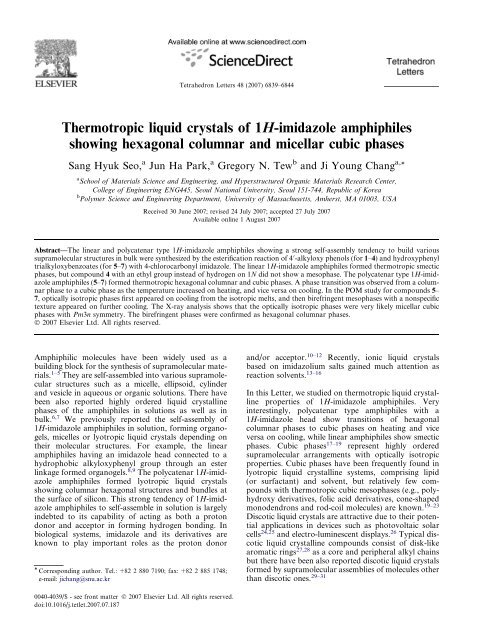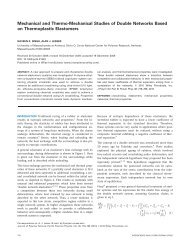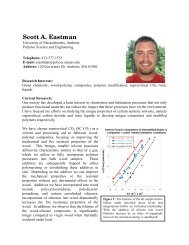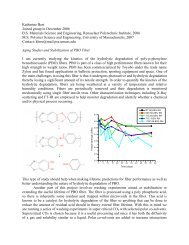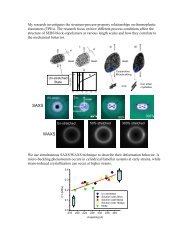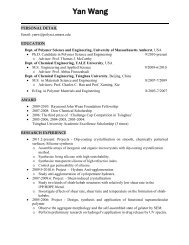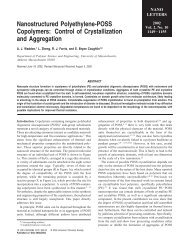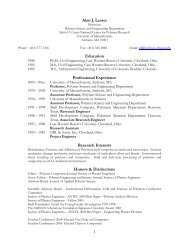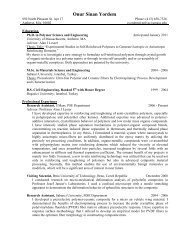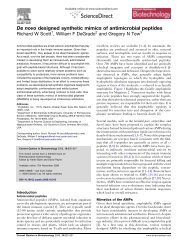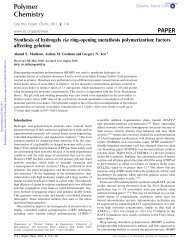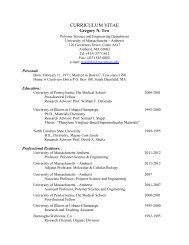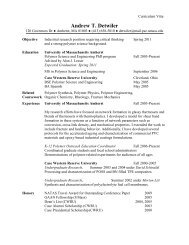Thermotropic liquid crystals of 1H-imidazole amphiphiles showing ...
Thermotropic liquid crystals of 1H-imidazole amphiphiles showing ...
Thermotropic liquid crystals of 1H-imidazole amphiphiles showing ...
You also want an ePaper? Increase the reach of your titles
YUMPU automatically turns print PDFs into web optimized ePapers that Google loves.
Tetrahedron Letters 48 (2007) 6839–6844<strong>Thermotropic</strong> <strong>liquid</strong> <strong>crystals</strong> <strong>of</strong> <strong>1H</strong>-<strong>imidazole</strong> <strong>amphiphiles</strong><strong>showing</strong> hexagonal columnar and micellar cubic phasesSang Hyuk Seo, a Jun Ha Park, a Gregory N. Tew b and Ji Young Chang a, *a School <strong>of</strong> Materials Science and Engineering, and Hyperstructured Organic Materials Research Center,College <strong>of</strong> Engineering ENG445, Seoul National University, Seoul 151-744, Republic <strong>of</strong> Koreab Polymer Science and Engineering Department, University <strong>of</strong> Massachusetts, Amherst, MA 01003, USAReceived 30 June 2007; revised 24 July 2007; accepted 27 July 2007Available online 1 August 2007Abstract—The linear and polycatenar type <strong>1H</strong>-<strong>imidazole</strong> <strong>amphiphiles</strong> <strong>showing</strong> a strong self-assembly tendency to build varioussupramolecular structures in bulk were synthesized by the esterification reaction <strong>of</strong> 4 0 -alkyloxy phenols (for 1–4) and hydroxyphenyltrialkyloxybenzoates (for 5–7) with 4-chlorocarbonyl <strong>imidazole</strong>. The linear <strong>1H</strong>-<strong>imidazole</strong> <strong>amphiphiles</strong> formed thermotropic smecticphases, but compound 4 with an ethyl group instead <strong>of</strong> hydrogen on 1N did not show a mesophase. The polycatenar type <strong>1H</strong>-<strong>imidazole</strong><strong>amphiphiles</strong> (5–7) formed thermotropic hexagonal columnar and cubic phases. A phase transition was observed from a columnarphase to a cubic phase as the temperature increased on heating, and vice versa on cooling. In the POM study for compounds 5–7, optically isotropic phases first appeared on cooling from the isotropic melts, and then birefringent mesophases with a nonspecifictexture appeared on further cooling. The X-ray analysis shows that the optically isotropic phases were very likely micellar cubicphases with Pm3n symmetry. The birefringent phases were confirmed as hexagonal columnar phases.Ó 2007 Elsevier Ltd. All rights reserved.Amphiphilic molecules have been widely used as abuilding block for the synthesis <strong>of</strong> supramolecular materials.1–5 They are self-assembled into various supramolecularstructures such as a micelle, ellipsoid, cylinderand vesicle in aqueous or organic solutions. There havebeen also reported highly ordered <strong>liquid</strong> crystallinephases <strong>of</strong> the <strong>amphiphiles</strong> in solutions as well as inbulk. 6,7 We previously reported the self-assembly <strong>of</strong><strong>1H</strong>-<strong>imidazole</strong> <strong>amphiphiles</strong> in solution, forming organogels,micelles or lyotropic <strong>liquid</strong> <strong>crystals</strong> depending ontheir molecular structures. For example, the linear<strong>amphiphiles</strong> having an <strong>imidazole</strong> head connected to ahydrophobic alkyloxyphenyl group through an esterlinkage formed organogels. 8,9 The polycatenar <strong>1H</strong>-<strong>imidazole</strong><strong>amphiphiles</strong> formed lyotropic <strong>liquid</strong> <strong>crystals</strong><strong>showing</strong> columnar hexagonal structures and bundles atthe surface <strong>of</strong> silicon. This strong tendency <strong>of</strong> <strong>1H</strong>-<strong>imidazole</strong><strong>amphiphiles</strong> to self-assemble in solution is largelyindebted to its capability <strong>of</strong> acting as both a protondonor and acceptor in forming hydrogen bonding. Inbiological systems, <strong>imidazole</strong> and its derivatives areknown to play important roles as the proton donor* Corresponding author. Tel.: +82 2 880 7190; fax: +82 2 885 1748;e-mail: jichang@snu.ac.krand/or acceptor. 10–12 Recently, ionic <strong>liquid</strong> <strong>crystals</strong>based on imidazolium salts gained much attention asreaction solvents. 13–16In this Letter, we studied on thermotropic <strong>liquid</strong> crystallineproperties <strong>of</strong> <strong>1H</strong>-<strong>imidazole</strong> <strong>amphiphiles</strong>. Veryinterestingly, polycatenar type <strong>amphiphiles</strong> with a<strong>1H</strong>-<strong>imidazole</strong> head show transitions <strong>of</strong> hexagonalcolumnar phases to cubic phases on heating and viceversa on cooling, while linear <strong>amphiphiles</strong> show smecticphases. Cubic phases 17–19 represent highly orderedsupramolecular arrangements with optically isotropicproperties. Cubic phases have been frequently found inlyotropic <strong>liquid</strong> crystalline systems, comprising lipid(or surfactant) and solvent, but relatively few compoundswith thermotropic cubic mesophases (e.g., polyhydroxyderivatives, folic acid derivatives, cone-shapedmonodendrons and rod-coil molecules) are known. 19–23Discotic <strong>liquid</strong> <strong>crystals</strong> are attractive due to their potentialapplications in devices such as photovoltaic solarcells 24,25 and electro-luminescent displays. 26 Typical discotic<strong>liquid</strong> crystalline compounds consist <strong>of</strong> disk-likearomatic rings 27,28 as a core and peripheral alkyl chainsbut there have been also reported discotic <strong>liquid</strong> <strong>crystals</strong>formed by supramolecular assemblies <strong>of</strong> molecules otherthan discotic ones. 29–310040-4039/$ - see front matter Ó 2007 Elsevier Ltd. All rights reserved.doi:10.1016/j.tetlet.2007.07.187
6840 S. H. Seo et al. / Tetrahedron Letters 48 (2007) 6839–6844<strong>1H</strong>-Imidazole <strong>amphiphiles</strong> were prepared according toour previous reports. 8,9 Linear <strong>1H</strong>-<strong>imidazole</strong> <strong>amphiphiles</strong>(1–3) were synthesized by the esterification reaction<strong>of</strong> 4 0 -alkyloxy phenol with 4-chlorocarbonyl<strong>imidazole</strong> under basic conditions. 32 For comparison,compound 4 was prepared, where 1N <strong>of</strong> the <strong>imidazole</strong>head was blocked by ethyl group. 33 Polycatenar<strong>1H</strong>-<strong>imidazole</strong> <strong>amphiphiles</strong> (5–7) were obtained by theesterification reaction <strong>of</strong> hydroxyphenyl trialkyloxybenzoateswith 4-chlorocarbonyl <strong>imidazole</strong> (Scheme1). 34 The structures were fully characterized by 1 H and13 C NMR spectroscopy and elemental analysis.The thermotropic properties <strong>of</strong> compounds 1–7 wereinvestigated by polarizing optical microscopy (POM),differential scanning calorimetry (DSC) and X-ray diffraction(XRD). In the DSC analysis, compounds 1–3show monotropic mesophases. Compound 2 show acrystal to crystal transition at 128 °C with an enthalpyvalue <strong>of</strong> 7.9 J/g and a melt transition at 155 °C withan enthalpy value <strong>of</strong> 52.6 J/g on heating. In the subsequentcooling cycle, an isotropic to <strong>liquid</strong> crystal transitionat 132 °C with an enthalpy value <strong>of</strong> 23.0 J/g and a<strong>liquid</strong> crystal to crystal transition at 111 °C with anHNHNHNNNNOC Cl + HO OROCCOCl+ HOOOCNaHDMFNaHDMFORORORHNNOC ONaH H 3 CH 2 CO OR + BrCH 2 CH 3 NDMFN123R =OC OHN COO OOCNORCH 2 (CH 2 ) 6 CH 3CH 2 (CH 2 ) 8 CH 3CH 2 (CH 2 ) 10 CH 3OR4 R = CH 2 (CH 2 ) 10 CH 3ORORORenthalpy value <strong>of</strong> 26.6 J/g occurred. In POM analysis,a birefringent phase was observed from 132 °C to111 °C on cooling (Fig. 1a). Compounds 1 and 3 alsoshow monotropic transitions similar to those <strong>of</strong> compound2. However, compound 4 with an ethyl groupinstead <strong>of</strong> hydrogen on 1N did not show a mesophase,supporting the idea that hydrogen bonding is criticalin these systems. Polycatenar compounds 5–7 havingone more phenyl group and two more side chains, comparedto compounds 1–3, exhibited both hexagonalcolumnar and cubic phases. A phase transition wasobserved from a columnar phase to a cubic phase asthe temperature increased on heating, and vice versaon cooling. Compound 7 show a crystal to hexagonalcolumnar phase transition at 48 °C with an enthalpyvalue <strong>of</strong> 3.6 J/g, a hexagonal columnar phase to cubicphase transition at 80 °C with an enthalpy value <strong>of</strong>14.0 J/g, and a cubic phase to isotropic <strong>liquid</strong> transitionat 114 °C with an enthalpy value <strong>of</strong> 0.42 J/g on heating.In the subsequent cooling cycle, an isotropic to cubicphase transition at 112 °C with an enthalpy value <strong>of</strong>0.05 J/g, a cubic phase to hexagonal columnar phasetransition at 86 °C with an enthalpy value <strong>of</strong> 10.4 J/g,and a hexagonal columnar phase to crystal transitionat 24 °C with an enthalpy value <strong>of</strong> 0.14 J/g occurred.Compounds 5 and 6 having shorter alkyl chains alsoshowed enantiotropic transitions similar to those <strong>of</strong>compound 7. Phase transition temperatures and correspondingenthalpy values for compounds 1–3 and 5–7are given in Table 1. In the POM study, only opticallyisotropic phases appeared initially on cooling fromthe isotropic melts <strong>of</strong> compounds 5–7, which is characteristic<strong>of</strong> a cubic structure. Birefringent mesophaseswith a nonspecific texture began to form on further cooling.A typical POM image obtained from 7 is shown inFigure 1b.The structures <strong>of</strong> the <strong>liquid</strong> <strong>crystals</strong> <strong>of</strong> 1–3 were investigatedby using an X-ray diffraction technique. In thesmall angle region, only one sharp reflection peakcorresponding to the d spacing <strong>of</strong> 31.5 Å (for 1),33.4 Å (for 2) and 34.5 Å (for 3) appeared (Fig. 2).Scheme 1.567R =CH 2 (CH 2 ) 6 CH 3CH 2 (CH 2 ) 8 CH 3CH 2 (CH 2 ) 10 CH 3Since the lengths <strong>of</strong> the molecules were calculated to be19.9 Å (for 1), 22.0 Å (for 2) and 24.4 Å (for 3), respectively,using a simple molecular modeling (MM2) method,it seems that they existed in a dimer form withFigure 1. Polarizing optical micrographs <strong>of</strong> (a) compound 2 and (b) 7 obtained at 130 °C and 65 °C, respectively, on cooling at a rate <strong>of</strong> 5 °C min 1 .
Table 1. Phase transition temperatures and enthalpy values (in parentheses) <strong>of</strong> <strong>1H</strong>-<strong>imidazole</strong> <strong>amphiphiles</strong> as determined by DSC (scan rate:5 °C min 1 ) or POM aCompound Phase transition temperature (°C) and D H(Jg 1 )2nd heating2nd cooling1 Cr 125 (5.4) Cr 154 (51.4) I I 131 (13.4) Sm 110 (27.8) Cr2 Cr 128 (7.9) Cr 155 (52.6) I I 132 (23.0) Sm 111 (26.6) Cr3 Cr 120 (17.4) Cr 146 (41.8) I I 134 (25.3) Sm 112 (27.9) Cr5 Cr 35 (3.9) Col h 95 (17.7) Cub 120 (0.04) I I 115 (0.01) Cub 94 (7.9) Col h 23 (0.04) Cr6 Cr 23 (2.0) Col h 82 (13.1) Cub 115 (0.02) I I 114 b Cub 91 (7.1) Col h 27 (0.06) Cr7 Cr 48 (3.6) Col h 80 (14.0) Cub 114 (0.42) I I 112 (0.05) Cub 86 (10.4) Col h 24 (0.14) Cra Abbreviations: Cr = crystalline; Sm = smectic; I = isotropic; Col h = hexagonal columnar; Cub = cubic mesophase.b Determined by POM.S. H. Seo et al. / Tetrahedron Letters 48 (2007) 6839–6844 6841Figure 2. X-ray diffractograms for the smectic phases <strong>of</strong> (a) compound1, (b) compound 2 and (c) compound 3 obtained at 120 °C on thesecond cooling.Figure 3. X-ray diffractograms for the hexagonal columnar phases <strong>of</strong>(a) compound 5, (b) compound 6 and (c) compound 7 obtained at40 °C on cooling.hydrogen bonding between <strong>imidazole</strong> moieties, formingsmectic structures. The observed layer distances weresmaller than twice the molecular lengths, indicatingeither a tilted arrangement <strong>of</strong> the molecules or interdigitation<strong>of</strong> the alkyl chains.The birefringent phases <strong>of</strong> polycatenar <strong>1H</strong>-<strong>imidazole</strong><strong>amphiphiles</strong> 5–7 were confirmed as columnar hexagonalphases. In the small angle X-ray diffractograms obtainedat 40 °C on cooling, three reflection peaks correspondingto the d spacings <strong>of</strong> 46.0, 26.7 and 23.4 Å (for 5)and 47.4, 27.8 and 23.6 Å (for 6) and 50.7, 28.8 and25.4 Å (for 7) appeared (Fig. 3). These reflections areindexed in sequence as (100), (110) and (200) <strong>of</strong> ahexagonal columnar lattice with the lattice parameter<strong>of</strong> a = 53.1 (for 5), 54.8 (for 6) and 58.5 (for 7). In addition,a diffuse halo is observed in the wide-angle regionat 4.55 (for 5), 4.52 (for 6) and 4.39 Å (for 7).The lengths <strong>of</strong> the molecules were calculated to be25.8 Å (for 5), 28.7 Å (for 6) and 31.0 Å (for 7), respectively,using the MM2 method, which were close to theradii <strong>of</strong> the corresponding disks determined by X-rayanalysis. Judging from these results and the structuralmotif <strong>of</strong> a polycatenar molecule, it is very likely thatthe molecules are arranged in a disk to form a longermesogen via hydrogen bonding between successive <strong>imidazole</strong>moieties as shown in Figure 5 (left). 8,9,35 Chainstructures <strong>of</strong> hydrogen bonded <strong>imidazole</strong> moleculeshave been found in the crystal state and in the solutionstate. 8,31,35 Assuming a density <strong>of</strong> q =1gcm 3 , thenumber (n) <strong>of</strong> molecules arranged side by side in a singleslice <strong>of</strong> the columns with a thickness (h) <strong>of</strong> approximately0.45 nm was estimated according to Eq. 1. 36n ¼ða 2 Þ p 3=2hðN A =MÞqð1ÞThe parameter a is the hexagonal lattice parameter, N Athe Avogadro constant and M the molecular mass. Thenumber <strong>of</strong> molecules in a disk at the thermotropiccolumnar state was calculated to be about 9–10.The X-ray analysis shows that the optically isotropicphases were very likely micellar cubic phases withPm3n symmetry (Fig. 4). 19–22 In the small angle X-raydiffractogram <strong>of</strong> compound 5 obtained at 100 °C oncooling, two reflections corresponding to d spacings <strong>of</strong>41.0 and 36.2 Å were observed. These reflections are indexedin sequence as (200) and (210) <strong>of</strong> a cubic phasewith a lattice parameter <strong>of</strong> a = 82.0 Å. Four reflections
6842 S. H. Seo et al. / Tetrahedron Letters 48 (2007) 6839–6844Figure 5. Schematic representation <strong>of</strong> a hexagonal columnar to cubicphase transition.Figure 4. X-ray diffractograms for the cubic phases <strong>of</strong> (a) compound 5obtained at 100 °C, (b) compound 6 obtained at 110 °C and (c)compound 7 obtained at 95 °C on cooling.corresponding to d spacings <strong>of</strong> 47.7, 42.2, 39.2 and33.6 Å for 6 at 110 °C and 49.0, 44.3, 40.9 and 34.7 Åfor 7 at 95 °C appeared. The relative positions <strong>of</strong> thesereflections are p 4, p 5, p 6 and p 8, which is in goodagreement with the (200), (210), (211) and (220) reflections<strong>of</strong> cubic phase with Pm3n symmetry with latticeconstants <strong>of</strong> 95.4 Å for 6 and 98.0 Å for 7. Assuminga density <strong>of</strong> q =1gcm 3 , the number (n cell ) <strong>of</strong> moleculesin each unit cell <strong>of</strong> the cubic lattice was estimatedaccording to Eq. 2. 36n cell ¼ V cell ðN A =MÞqð2ÞThe parameter V cell is the volume <strong>of</strong> unit cell <strong>of</strong> cubiclattice, N A the Avogadro constant and M the molecularmass. The number <strong>of</strong> molecules in each unit cell <strong>of</strong> thecubic lattice (n cell ) at the cubic state is 479 for 5, 673for 6 and 658 for 7.Since the molecular lengths <strong>of</strong> the <strong>amphiphiles</strong> weremuch smaller than the lattice parameters (e.g., the cubicphase <strong>of</strong> 7 has a lattice parameter <strong>of</strong> a = 98.0 Å, whilethe calculated molecular length is 31.0 Å), the possibility<strong>of</strong> the arrangement <strong>of</strong> spherical micelles in a primitivecubic cell were excluded. Under similar circumstances,Fontell et al. and Tschierske et al. proposed a thermotropicmicellar cubic phase in which eight short rod-likeaggregates (inverted micelles) formed a cubic unit cell(Pm3n). One <strong>of</strong> these rod-like micelles is located at eachcorner <strong>of</strong> the unit cell, one in the center and the othertwo on each face <strong>of</strong> the unit cell. 23,37,38 We presume thatthe polycatenar <strong>1H</strong>-<strong>imidazole</strong> <strong>amphiphiles</strong> reported herealso formed the cubic lattices built up by eight short rodlikemicelles with each micelle consisting <strong>of</strong> approximately60 (for 5), 84 (for 6) and 82 (for 7) individualmolecules (Fig. 5 (right)). The Pm3n lattice seems tobe the generally favoured packing motif <strong>of</strong> rod-like orspherical micelles as it provides a dense packing withminimum interfaces. 20In summary we prepared the linear and polycatenar type<strong>1H</strong>-<strong>imidazole</strong> <strong>amphiphiles</strong> where an <strong>imidazole</strong> head wasconnected to a hydrophobic alkyloxyphenyl or ahydroxyphenyl trialkyloxybenzoate group through anester linkage. The polycatenar <strong>1H</strong>-<strong>imidazole</strong> <strong>amphiphiles</strong>formed thermotropic <strong>liquid</strong> <strong>crystals</strong> having hexagonalcolumnar and cubic structures. The transitionsfrom a columnar mesophase to a cubic phase wereobserved as the temperature increased on heating, andvice versa on cooling. The linear type <strong>1H</strong>-<strong>imidazole</strong><strong>amphiphiles</strong> formed thermotropic smectic phases. Whenhydrogen on 1N <strong>of</strong> an <strong>imidazole</strong> ring was substituted byan ethyl group, the compound did not show <strong>liquid</strong> crystalphase, strongly suggesting that the capability <strong>of</strong> a<strong>1H</strong>-<strong>imidazole</strong> to act as a proton donor as well as anacceptor in forming hydrogen bonding plays a majorrole in its self-assembly.AcknowledgementsFinancial supports from the Hyperstructured OrganicMaterials Research Center at Seoul National Universityand the Ministry <strong>of</strong> Commerce, Industry and Energy,Korea are gratefully acknowledged. The work at theUniversity <strong>of</strong> Massachusetts was supported by theNSF through the MERSEC (DMR 9400488).References and notes1. Hill, J. P.; Jin, W.; Kosaka, A.; Fukushima, T.; Ichihara,H.; Shimomura, T.; Ito, K.; Hashizume, T.; Ishii, N.;Aida, T. Science 2004, 304, 1481.2. Percec, V.; Dulcey, A. E.; Balagurusamy, V. S. K.; Miura,Y.; Smidrkal, J.; Peterca, M.; Nummelin, S.; Edlund, U.;Hudson, S. D.; Heiney, P. A.; Duan, H.; Magonov, S. N.;Vinogradov, S. A. Nature 2004, 430, 764.3. Hong, S. W.; Kim, K. H.; Huh, J.; Ahn, C.-H.; Jo, W. H.Macromol. Res. 2005, 13, 397.4. Li, G.; Fudickar, W.; Skupin, M.; Klyszcz, A.; Draeger,C.; Lauer, M.; Fuhrhop, J.-H. Angew. Chem., Int. Ed.2002, 41, 1828.5. Lee, M.; Kim, J.-W.; Peleshanko, S.; Larson, K.; Yoo, Y.-S.; Vaknin, D.; Markutsya, S.; Tsukruk, V. V. J. Am.Chem. Soc. 2002, 124, 9121.6. Lindner, N.; Kölbel, M.; Sauer, C.; Diele, S.; Jokiranta, J.;Tschierske, C. J. Phys. Chem. B 1998, 102, 5261.7. Kölbel, M.; Beyersdorff, T.; Tschierske, C.; Diele, S.;Kain, J. Chem. Eur. J. 2000, 6, 3821.
S. H. Seo et al. / Tetrahedron Letters 48 (2007) 6839–6844 68438. Seo, S. H.; Chang, J. Y. Chem. Mater. 2005, 17,3249.9. Seo, S. H.; Tew, G. N.; Chang, J. Y. S<strong>of</strong>t Mat. 2006, 10,886.10. Breslow, R. Acc. Chem. Rec. 1991, 24, 317.11. Schneider, F. Angew. Chem., Int. Ed. Engl. 1978, 17,583.12. Katrusiak, A. J. Mol. Struct. 1999, 474, 125.13. Suisse, J.-M.; Bellemin-Laponnaz, S.; Douce, L.; Maisse-François, A.; Welter, R. Tetrahedron Lett. 2005, 46,4303.14. Kumar, S.; Pal, S. K. Tetrahedron Lett. 2005, 46, 2607.15. Dobbs, W.; Douce, L.; Allouche, L.; Louati, A.; Malbose,F.; Welter, R. New J. Chem. 2006, 30, 528.16. Bradley, A. E.; Hardacre, C.; Holbrey, J. D.; Johnston, S.;McMath, S. E. J.; Nieuwenhuyzen, M. Chem. Mater.2002, 14, 629.17. Cheng, X. H.; Diele, S.; Tschierske, C. Angew. Chem., Int.Ed. 2000, 39, 592.18. Yang, D.; Armitage, B.; Marder, S. R. Angew. Chem., Int.Ed. 2004, 43, 4402.19. Kato, T.; Matsuoka, T.; Nishii, M.; Kamikawa, Y.;Kanie, K.; Nishimura, T.; Yashima, E.; Ujiie, S. Angew.Chem., Int. Ed. 2004, 43, 1969.20. Ungar, G.; Zeng, X. S<strong>of</strong>t Mat. 2005, 1, 95.21. Yeardley, D. J. P.; Ungar, G.; Percec, V.; Holerca, M. N.;Johansson, G. J. Am. Chem. Soc. 2000, 122, 1684.22. Cheng, X.; Das, M. K.; Diele, S.; Tschierske, C. Langmuir2002, 18, 6521.23. Lee, M.; Cho, B.-K.; Kim, H.; Zin, W.-C. Angew. Chem.,Int. Ed. 1998, 37, 638.24. Yoshio, M.; Mukai, T.; Ohno, H.; Kato, T. J. Am. Chem.Soc. 2004, 126, 994.25. Palmans, A. R. A.; Vekemans, J. A. J. M.; Hikmet, R. A.;Fischer, H.; Meijer, E. W. Adv. Mater. 1998, 10, 873.26. Hulvat, J. F.; S<strong>of</strong>os, M.; Tajima, K.; Stupp, S. I. J. Am.Chem. Soc. 2005, 127, 366.27. Chang, J. Y.; Baik, J. H.; Lee, C. B.; Han, M. J.; Hong,S.-K. J. Am. Chem. Soc. 1997, 119, 3197.28. Percec, V.; Ahn, C.-H.; Bera, T. K.; Ungar, G.; Yeardley,D. J. P. Chem. Eur. J. 1999, 5, 1070.29. Hwang, I. H.; Lee, S. J.; Chang, J. Y. J. Polym. Sci.Polym. Chem. Ed. 2003, 41, 1881.30. Lee, H.-K.; Lee, H.; Ko, Y. H.; Chang, Y. J.; Oh, N.-K.;Zin, W.-C.; Kim, K. Angew. Chem., Int. Ed. 2001, 40,2669.31. Shu, W.; Valiyaveettil, S. Chem. Commun. 2002, 1350.32. Compounds 1–3: These compounds were prepared accordingto our previous report. 8 A typical procedure is asfollows: 4-Imidazole carboxylic acid (1 g, 9 mmol) inbenzene (10 mL) was stirred at room temperature, andthen thionyl chloride (10 mL) dissolved in benzene(10 mL) was added slowly. The mixture was refluxed for10 h. After evaporation, the product (4-chlorocarbonyl<strong>imidazole</strong>)was dried and used for the next reactionwithout further purification. To a solution <strong>of</strong> 4 0 -octyloxyphenol (1 g, 4.40 mmol) and sodium hydride (0.13 g,4.84 mmol) in DMF (50 mL) was added 4-chlorocarbonyl<strong>imidazole</strong>(0.83 g, 4.84 mmol) under nitrogen. The reactionmixture was stirred for 24 h at 90 °C. After removal<strong>of</strong> precipitates by filtration, the filtrates were concentratedto dryness by evaporation under reduced pressure. Theproduct (compound 1) was isolated by column chromatographyon silica gel (THF/n-hexane = 3/1); yield 0.93 g(60%). 1 H NMR (300 MHz, DMSO): d = 12.82 (s, <strong>1H</strong>,NH), 8.03, 7.88 (s, 2H, <strong>imidazole</strong> ring protons), 7.10, 6.95(dd, 4H, ArH), 3.96 (t, 2H, ArOCH 2 ), 1.73–1.28 (m, 12H,CH 2 ), 0.85 (t, 3H, CH 3 ). 13 C NMR (75 MHz, DMSO): d164.4, 139.1, 133.6, 120.5, 117.2, 85.3, 75.1, 74.6, 65.6,31.7, 29.0, 28.7, 22.9, 20.0, 14.5. IR (KBr pellet, cm 1 ):3141, 3011, 2920, 2850, 2654, 2593, 1728, 1508, 1449, 1336,1199, 979. Compound 2: Yield 0.92 g (55%). 1 H NMR(300 MHz, DMSO): d 12.82 (s, <strong>1H</strong>, NH), 8.03, 7.88 (s, 2H,<strong>imidazole</strong> ring protons), 7.10, 6.95 (dd, 4H, ArH), 3.96 (t,2H, ArOCH 2 ), 1.73–1.28 (m, 16H, CH 2 ), 0.85 (t, 3H,CH 3 ). 13 C NMR (75 MHz, DMSO): d 164.4, 139.1, 133.6,120.5, 117.2, 85.3, 75.1, 74.6, 65.6, 32.2, 29.6, 29.5, 29.3,28.7, 23.1, 20.0, 14.5. IR (KBr pellet, cm 1 ): 3141, 3011,2920, 2851, 2654, 2593, 1729, 1508, 1447, 1338, 1199, 977.Compound 3: Yield 0.93 g (52%). 1 H NMR (300 MHz,DMSO): d 12.80 (s, 3H, NH), 8.05, 7.88 (s, 2H, <strong>imidazole</strong>ring protons), 7.09, 6.96 (dd, 4H, ArH), 3.96 (t, 2H,ArOCH 2 ), 1.70-1.25 (m, 20H, CH 2 ), 0.86 (t, 3H, CH 3 ). 13 CNMR (75 MHz, DMSO): d 164.2, 138.9, 133.4, 120.3,117.0, 85.0, 74.8, 74.4, 65.4, 32.1, 29.8, 29.7, 29.5, 29.3,29.1, 28.5, 22.9, 19.8, 14.3. IR (KBr pellet, cm 1 ): 3152,3010, 2917, 2851, 2654, 2585, 1733, 1507, 1446, 1342, 1199,982.33. Compound 4: This compound was prepared according toour previous report. 8 To a solution <strong>of</strong> compound 3 (0.2 g,0.49 mmol) and sodium hydride (0.015 g, 0.54 mmol) inDMF (15 mL) was added 1-bromoethane (0.15 mL,1.47 mmol) under nitrogen. The reaction mixture wasstirred for 24 h at 90 °C. After removal <strong>of</strong> precipitates byfiltration, the filtrates were concentrated to dryness byevaporation under reduced pressure. The product wasisolated by column chromatography on silica gel (EA/nhexane= 2/1); yield 0.19 g (90%). 1 H NMR (300 MHz,DMSO): d 7.88, 7.58 (s, 2H, <strong>imidazole</strong> ring protons), 7.10,6.90 (dd, 4H, ArH), 4.07 (q, 2H, N–CH 2 ), 3.94 (t, 2H,ArOCH 2 ), 2.17 (t, 3H, N–CH 2 CH 3 ), 1.75–1.27 (m, 20H,CH 2 ), 0.88 (t, 3H, CH 3 ). 13 C NMR (75 MHz, DMSO): d164.5, 139.3, 133.4, 120.4, 117.2, 85.1, 74.8, 74.4, 65.4,39.9, 32.1, 29.8, 29.7, 29.5, 29.3, 29.1, 28.5, 22.9, 19.8, 16.4,14.3. IR (KBr pellet, cm 1 ): 3101, 2923, 2852, 1740, 1506,1386, 1245, 1191, 1171, 1080, 966.34. Compounds 5–7: These compounds were prepared accordingto our previous report. 9 A typical procedure is asfollows. To a solution <strong>of</strong> 4-hydroxyphenyl 3,4,5-tris(noctan-1-yloxy)benzoate9 (1 g, 1.7 mmol) in DMF (50 mL)was added sodium hydride (0.05 g, 2.0 mmol). Afterstirring for 1 h at room temperature, 4-chlorocarbonyl<strong>imidazole</strong> (1.24 g, 7.4 mmol) was added. The solution wasstirred for 24 h at 90 °C. After filtration and evaporation,the product (compound 5) was isolated by columnchromatography on silica gel (THF/n-hexane = 2/1 v/v)and further purified by recrystallization from THF/nhexane;(65 % yield). 1 H NMR (300 MHz, CDCl 3 ): d 7.92,7.84 (s, 2H, <strong>imidazole</strong> ring protons), 7.41 (s, 2H, ArH),7.27 (dd, 4H, ArH), 4.05 (t, 6H, ArOCH 2 ), 1.29–1.86 (m,36H, CH 2 ), 0.88 (t, 9H, CH 3 ).13 C NMR (75 MHz,CDCl 3 ): d 165.47, 161.30, 153.22, 148.69, 148.28, 143.41,138.10, 123.80, 123.07, 122.98, 108.87, 73.87, 69.53, 32.11,32.03, 31.12, 30.57, 29.72, 29.56, 29.53, 29.49, 26.31, 26.26,22.90, 22.87, 13.80. IR (KBr pellet, cm 1 ): 3113, 3078,2925, 2663, 2598, 1732, 1504, 1336, 1178, 1127, 976.Compound 6: 1 H NMR (300 MHz, CDCl 3 ): d 7.92, 7.84(s, 2H, <strong>imidazole</strong> ring protons), 7.41 (s, 2H, ArH), 7.26(dd, 4H, ArH), 4.05 (t, 6H, ArOCH 2 ), 1.29–1.86 (m, 48H,CH 2 ), 0.87 (t, 9H, CH 3 ). 13 C NMR (75 MHz, CDCl 3 ): d165.44, 160.82, 153.22, 148.70, 148.22, 143.42, 138.08,123.78, 123.03, 122.96, 108.86, 73.85, 69.53, 32.15, 32.12,30.56, 29.94, 29.90, 29.88, 29.84, 29.79, 29.61, 29.55, 29.52,26.30, 26.27, 22.90, 14.31. IR (KBr pellet, cm 1 ): 3113,3068, 2852, 2666, 2600, 1735, 1502, 1338, 1180, 1122, 976.Compound 7: 1 H NMR (300 MHz, CDCl 3 ): d 7.92, 7.84(s, 2H, <strong>imidazole</strong> ring protons), 7.41 (s, 2H, ArH), 7.26(dd, 4H, ArH), 4.05 (t, 6H, ArOCH 2 ), 1.29–1.86 (m, 60H,
6844 S. H. Seo et al. / Tetrahedron Letters 48 (2007) 6839–6844CH 2 ), 0.87 (t, 9H, CH 3 ). 13 C NMR (75 MHz, CDCl 3 ): d165.45, 160.65, 153.22, 148.71, 148.20, 143.43, 138.06,123.77, 123.02, 122.96, 108.86, 73.85, 69.53, 32.15,32.13, 30.57, 29.94, 29.91, 29.87, 29.85, 29.79, 29.62,29.57, 29.53, 26.31, 26.28, 22.90, 14.3. IR (KBr pellet,cm 1 ): 3113, 3078, 2852, 2664, 2598, 1733, 1504, 1337,1177, 1121, 976.35. Münch, W.; Kreuer, K.-D.; Silvestri, W.; Maier, J.;Seifert, G. Solid State Ionics 2001, 145, 437.36. Borisch, K.; Diele, S.; Göring, P.; Kresse, H.; Tschierske,C. J. Mater. Chem. 1998, 8, 529.37. Fontell, K.; Fox, K. K.; Hansson, E. Mol. Cryst. Liq.Cryst. Lett. Sect. 1985, 1, 9.38. Fontell, K. Colloid Polym. Sci. 1990, 268, 264.


